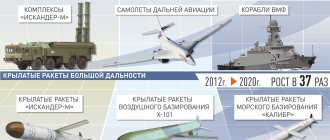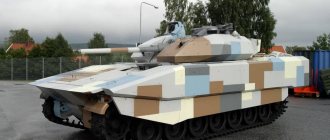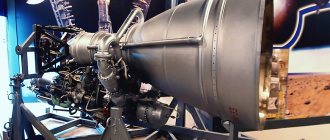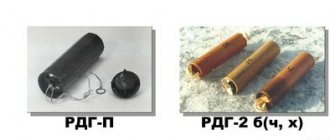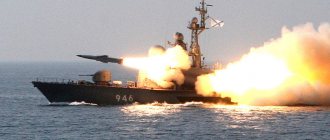Materials on the V-2 rocket
- V-2 rocket more details
- The structure of the V-2 rocket in more detail
- Combat compartment of the V-2 rocket in more detail
- Fuel and tail compartments of the V-2 rocket in more detail
- V-2 rocket control system
- List of V-2 rocket launches more details
- List of German V-2 rockets by numbers more details
- Test table (versuch) of German V-2 ballistic missiles more details
The control system of the V-2 rocket consists of three main devices: a gyrohorizon, a gyroverticant and an axial overload integrator. The executive bodies are steering gears and gas rudders.
Block diagram of the V-2 rocket control system
Gyrohorizon
The gyro horizon is designed to stabilize the rocket's pitch angle. He also sets the program for changing the pitch angle of the rocket. The gyroscope of this device is placed in a gimbal suspension so that the rotor axis is horizontal and lies in the firing plane. The gyroscope rotor is the anchor of the electric motor and spins up a few minutes before the start.
After the start, if the axis deviates from the vertical, the gyroscope axis will remain motionless and a mismatch signal will appear on the potentiometer, which, after conversion and amplification, affects the steering machine. which will deflect the rudders and return the rocket to its original position. Immediately after the start, the program mechanism is turned on, which consists of a stepper motor, an eccentric (which, in fact, sets the program), a belt and a pulley. The stepper motor turns the eccentric, the profile of which corresponds to the specified pitch change program, and it, in turn, turns the potentiometer. As a result of turning the potentiometer, a mismatch signal appears, which acts on the rocket's rudders and turns the rocket to a given angle. This ensures that the desired throwing angle is achieved.
Gyroverticant
The gyroverticant provides stabilization in terms of heading and roll. The rotor axis is located perpendicular to the firing plane. Therefore, the gyroscope turns out to be insensitive to changes in the pitch angle of the rocket. but reacts to turns and course deviations. Signals from the gyroverticant are taken from two potentiometers that act on rudders 1 and 2. Before launch, the rocket is set so that the plane of rudders 1 and 2 coincides with the firing plane.
In addition to these two devices, some V-2 rockets were equipped with a system for lateral radio correction of the position of the firing plane. The lateral radio correction system keeps the missile in the equal-signal zone, which reduces the likelihood of the missile lateral drift. This system was not always used, mainly due to the complexity of the entire system and susceptibility to radio interference.
Features of inertial-satellite systems
This is a promising class of integrated navigation systems that combine the advantages of satellite signal sources and the inertial models under consideration. Unlike popular satellite systems, such complexes make it possible to additionally use angular orientation data and create independent algorithms for determining location in the absence of navigation signals. Obtaining additional geolocation information allows one to technically simplify models of sensitive elements, eliminating the need for expensive equipment. The advantages of an inertial satellite navigation system include light weight, small size and simplified data processing schemes. On the other hand, the instability of microelectromechanical gyroscopes causes the accumulation of errors in data determination.
Axial load integrator
The axial load integrator is the third device in the control system. The V-2 rocket used two types of integrators - gyroscopic and electrolytic.
Gyroscopic axial load integrator
The gyroscopic integrator of axial overloads consists of a gyroscope, the rotor of which is suspended in a special bracket. Before launch, the rotor axis is set perpendicular to the longitudinal axis of the rocket. At the moment of launch, the bracket is released and a moment begins to act on it, which arises from the action of gravity and acceleration of the rocket. Under the influence of this moment, the gyroscope begins to precess (rotate) around the vertical axis. The number of revolutions of the outer integrator bracket is proportional to the speed gained by the rocket. After a predetermined number of revolutions of the outer bracket, a cam on the disk gives a signal to switch the engine to eight-ton thrust. This makes it possible to more accurately record the moment the engine turns off after reaching a given speed and to avoid hydraulic shocks in the rocket fuel system. Once the required speed is reached, the second cam will give a signal to stop the engine. This type of integrator allowed the missile to be guided with an error of 4 km at a range of 300 km.
Electrolytic axial load integrator
The electrolytic axial load integrator was used in later series of the V-2 rocket.
The electrolytic axial overload integrator consisted of two main parts:
- device for producing direct current proportional to acceleration;
- an electrolytic cell for integrating the current thus obtained.
The first device consisted of a magnetoelectric device with a permanent magnet and a pendulum attached to a coil. This pendulum is installed so that it swings under straight lines to the axis of the rocket, and in this position it is held against the acceleration force by the rotating counter-moment created by the coil.
The current in the coil was precisely regulated and was proportional to the acceleration; To integrate the current, an electrolytic cell with two silver electrodes was used, one of which was coated with a thick layer of silver chloride. This electrolytic cell was prepared for use by imparting a negative charge to the coated electrode and passing through it a current corresponding to a unit of acceleration for a known period of time, which caused a certain amount of silver chloride to transfer to the uncoated electrode. The poles were then switched and the element was ready for action.
During the flight, the newly deposited silver was transferred back to the thickly coated electrode, and the completion of this operation was marked by an increase in electromotive force of the order of 1 V, which activated a mechanism that stopped the fuel supply. The deviation from the target when using an electrolytic cell was considered equal to 1.6-2 km.
It should be noted that the basic design of the control system developed by German specialists remained unchanged for a long time on all Soviet and American missiles, including the world's first intercontinental ballistic missile R-7.
System components
Mandatory elements of any inertial system are blocks of sensitive measuring devices and computing instruments. The first category of elements is represented by gyroscopes and accelerometers, and the second is computer equipment that implements certain calculation algorithms. The accuracy of the method largely depends on the characteristics of the sensitive devices. For example, reliable data make it possible to obtain inertial navigation systems only with precision gyroscopes in conjunction with accelerometers. But in this case, the technical equipment has a serious drawback in the form of the high complexity of the electromechanical filling, not to mention the large size of the equipment.
Radio control devices for the V-2 rocket
Initially, to determine the speed of a rocket, it was planned to use a radio device based on the Doppler effect. But it was abandoned due to poor noise immunity.
Experiments with radio-controlled rockets have been conducted in Germany since 1933. By 1939, radiotelemetric means for remote control were developed, and in 1941 they were first used on the V-2 rocket.
Radio control was necessary to measure the speed of the rocket, to transmit commands to turn off the rocket engine, to determine the location of the rocket's impact, and to control the rocket's flight along the course. For each radio control function, a separate radio line (radiopath) was intended, and they were all developed in separate parts. Therefore, the equipment was bulky and expensive.
Since 1944, V-2 rockets began to use equipment developed using an integrated method: by combining radiopaths previously intended for separate functions. New complex systems were created: “Hawaii 2”, “Zirkel”, “Evator”. The first modifications of the radio control of the V-2 rocket used equipment operating on ultra-short wavelength waves. Such equipment was very susceptible to interference, especially since for a long time no special measures were taken to increase noise immunity. At that time, German experts assumed that when conducting group firing of missiles, the radio control of which operates at different wavelengths, it was very unlikely to interfere with and intercept the missiles.
The first radiotelemetry control systems used the equal-signal zone method. That is, the rocket must move along a strictly defined path specified by the radio device. In case of deviation from this path, the receiving device on the rocket receives the corresponding signal, processes it in the receiver and in the Mishgeret mixing device, from where it goes to the steering engines, which, using gas rudders, return the rocket to the desired position on the given flight path.
The equal-signal zone is determined by the operation of the radio navigation line “Hawaii 1 B - Victoria”. The ground transmitter "Hawaii 1B" operated on VHF in the range of 5.8 - 6.8 m. The radiation pattern was sent with a slight offset from the "axis" of the flight path (0.7 degrees) in both directions alternately (50 times per second). The Hawaii 1B transmitter fed two antennas spaced 35 wavelengths (300 m) apart.
The axis of the equal-signal zone should not have been shifted by more than 0.005 degrees. An alternating current source N = 15 kW fed the Khaze transmitter, which provided an equal-signal zone. The high-frequency energy was then passed through the Cabin device, where power and runaway coefficient were measured, to the Pfad phase-shift keying device and to the antenna. On board the rocket for receiving the equal-signal zone there was a Victoria receiver and Mischgeret converters (Das Mischgerät - German - electronic analog computing device), etc.
To turn off the rocket engine and to measure speed, the Naples transmitter and the Saleris receiver were placed on the ground. On board the rocket, respectively, were placed the Palermo or Hase transmitters, the Heide modulator, which serves to generate the fuel cut-off command, the Hazum camouflage device and the Ortler transceiver (“Das Ortler-Gerät” - German - special transceiver for duplicating missile radio control frequencies) - for measuring speed.
The antenna of the Khaze transmitter gave a narrow radiation pattern in the horizontal plane and a wide opening in the vertical plane. This allowed the enemy to detect the work of the Khaze and create interference. Therefore, German specialists designed and created the Hawaii-2 installation, in which, instead of creating an equal-signal zone in the plane in the direction of the rocket’s flight, a leading beam was created, which also represented an equal-signal zone. It was very difficult to detect such a beam. In the Hawaii-2 system, an equal-signal zone was created with shorter waves, first 50 cm and then 20 cm. To obtain a narrow leading beam in the parabolic mirror of the antenna device, the measuring dipole was placed outside the axis of the reflector. When the dipole rotated around the reflector axis, a cone-shaped radiation pattern was formed with an equal-signal zone coinciding with the optical axis of the reflector.
A missile with radio-telemechanical control at a range of 250 km was considered to be of sufficient accuracy and equal to ± 300 m in azimuth. But usually such accuracy of hits was not achieved by the V-2 missile.
Author: Igor Makarov.
Part 5.
Part 1. Part 2. Part 3. Part 4.
Additionally, a formula was used to determine the radius of rotation of the launch vehicle.
The second stage of the trajectory of the launch vehicle overcomes the separation from the load-bearing surfaces with the help of a braking parachute.
The definition in the first group of formulas and the second are the same, namely: x is the ordinate of the point, y is the abscissa of the point, Vx is the projection of velocity on the x-axis, Vy is the projection of velocity on the y-axis, Me is the moment of external forces acting on the body, and is the moment inertia of the body (launch vehicle), Ɛ - angular acceleration of the launch vehicle, Xa - aerodynamic drag, Ua - aerodynamic lift force, Ɵ - pitch angle of the aircraft, Ckha - aerodynamic drag coefficient of the launch vehicle, Sua - wing lift coefficient launch vehicle, ω - angular velocity of the body, m - mass of the body (launch rocket), g - acceleration of gravity (9.81 m/s2), ρ - air density, Sp - area of the open braking parachute, Sm - area of the midship cross-section of the launch vehicle, Sv is the wing area of the launch vehicle, r is the maneuver radius of the launch vehicle, ny is the normal overload of the launch vehicle.
Radio telemetry of the V-2 rocket
German designers did not immediately come to the need to create and use radiotelnmetry. Testing of a specially designed experimental prototype of the V-2 rocket, known as the A-3 rocket, began in 1937 without the use of radio telemetry. They tried to find out the causes of the accidents from rocket fragments found on the ground. Later, German engineers came up with the idea of receiving information about the state of the rocket in flight, from the records of rescued single-channel recorders of controlled data on a narrow paper recorder tape.
To support research on the ballistics and firing accuracy of V-2 missiles, it was necessary to develop special on-board and ground-based radio equipment. For this purpose, a 4-channel telemetry system “Messina-1” was created. Using Messina-1, the following indicators of the rocket in flight were recorded on the tape of the ground receiving apparatus: deflection of the gas rudders, pressure in the combustion chamber, oxygen and alcohol supply pressure, steam pressure at the turbine inlet, engine start time. But this system was so unreliable that Wernher von Braun once said that it would be more effective to track the rocket through binoculars.
This system had the following parameters:
- included four measuring channels
- had frequency division of channels
- had a sampling frequency of one channel - 2 kHz
- was recorded by ground-based equipment on photo tape
(Polenov D. Yu. Evolution of telemetry in rocket technology // Young scientist. - 2014. - No. 6. - P. 216-218.)
Up
Methods for determining the orientation of platform systems
Systems that work with platforms to determine initial data on the dynamics of an object also remain relevant. At the moment, the following types of platform inertial navigation models are successfully used:
- Geometric system. Standard model with two platforms, which was described above. Such systems are highly accurate, but have limitations in servicing highly maneuverable vehicles operating in outer space.
- Analytical system. It also uses accelerometers and gyroscopes, which are stationary relative to the stars. The advantages of such systems include the ability to effectively service maneuverable objects such as missiles, helicopters and fighter jets. But even in comparison with a strapdown inertial navigation system, analytical systems demonstrate low accuracy in determining the parameters of an object’s dynamics.
- Semi-analytical system. It is provided by one platform, continuously stabilizing in the space of the local horizon. This base houses a gyroscope and an accelerometer, and calculations are organized outside the working platform.
